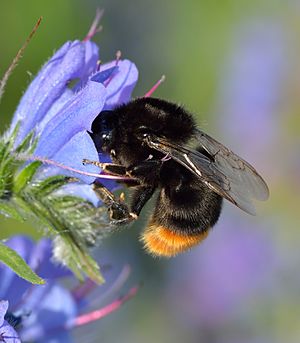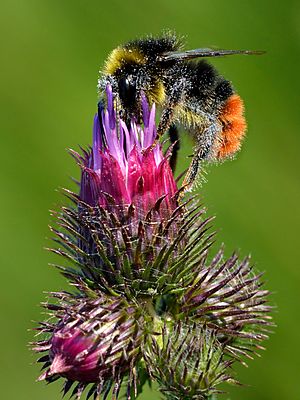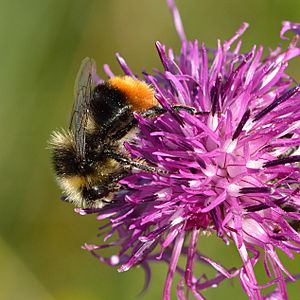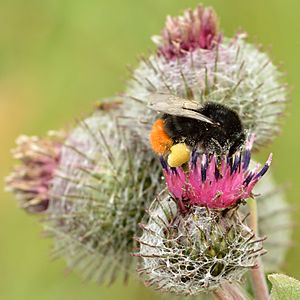Red-tailed bumblebee facts for kids
Quick facts for kids Red-tailed bumblebee |
|
|---|---|
 |
|
| Queen | |
 |
|
| Drone | |
| Scientific classification | |
| Genus: |
Bombus
|
| Species: |
lapidarius
|
The Bombus lapidarius, also known as the red-tailed bumblebee, is a type of bumblebee. You can find these bees across much of Central Europe. They are easy to spot because of their unique black body and bright red tail. These social bees play a very important role in pollination, helping plants grow.
Contents
What is a Red-tailed Bumblebee?
The red-tailed bumblebee belongs to a large group of insects called Hymenoptera. This group includes bees, wasps, and ants. It is part of the bee family called Apidae. Within this family, it belongs to the Bombus genus. Other well-known bumblebees like Bombus terrestris and Bombus lucorum are also in this group.
How to Spot a Red-tailed Bumblebee
Red-tailed bumblebees are mostly black with a clear red patch on their rear end. The queen bee and the worker females look quite similar. However, the queen is much bigger than the workers. Male bees, called drones, also have the red and black colors. But they often have a yellow band around their middle and yellow marks on their face.
These bees have a medium-sized tongue, called a proboscis. This helps them reach nectar deep inside flowers, making them great pollinators. Their nests are not usually very large or complicated. A typical colony might have about 100 to 200 worker bees.
Where Do Red-tailed Bumblebees Live?
You can find Bombus lapidarius all over Europe. This includes places like Britain, Ireland, Greece, Germany, Sweden, and Finland. They prefer to live in places with mild weather.
These bees build their nests in many different areas. They usually like open spaces more than thick forests. They can fly quite far, sometimes over 1,500 meters, to find food.
Life Cycle of a Red-tailed Bumblebee Colony
Red-tailed bumblebees are most active during the summer months. This is usually from June to August. A new colony starts when a queen bee begins to lay eggs. The workers and males then take on different jobs to help the colony grow. While the queen is in charge, the worker bees do not seem to have a strict leader among themselves.
How Bees Keep Their Brood Warm
Social bees, like the red-tailed bumblebee, can create a lot of heat. They do this by moving their flight muscles very fast. They use this warmth to keep their young, called the brood, warm. This also helps them control the temperature inside their nest.
How Male Bees Attract Mates
Male red-tailed bumblebees use special scents, called pheromones, to find females. The males fly around and mark certain spots with these scents. These scents are very specific to their species. This helps make sure they only mate with other red-tailed bumblebees.
These bees often release their scents above treetops. Because of the wind and sun, they sometimes need to use more pheromone to be effective. Bees from different areas, like Southern Italy or Germany, might have slightly different scent mixtures.
What are Pheromones?
Pheromones are like chemical messages. Male red-tailed bumblebee pheromones are thought to be "pre-mating signals." They are used to attract a partner. Interestingly, some cuckoo bee species can copy these scents to trick other bees.
Queen red-tailed bumblebees also release pheromones. These scents seem to stop worker bees from developing their own eggs. However, scientists are still learning the full purpose of the queen's pheromones. We do know their chemical makeup is different from worker bee pheromones.
How Red-tailed Bumblebees Find Food
Bombus lapidarius is a strong forager. They can travel as far as 1,750 meters to find food like Phacelia tenuifolia. However, how far each bee travels can be very different.
One study watched red-tailed bumblebees in Germany. It found that bees spent the most time foraging about 500 meters from their nest. The time spent decreased as they went farther away. Also, some bees flew much farther than others. This suggests that some bees might be better at finding food over long distances.
Red-tailed bumblebees often return to the same good feeding spots. This means they are loyal to their food patches. They are known as "long-distance foragers," but some other bumblebee species fly even farther. So, they are considered to have an intermediate foraging distance. The study also found that a bee's body size might affect how far it travels for food.
Roles of Males and Workers
Male bees tend to travel much farther than worker bees. This helps mix up the genes in different bee groups. This way, bees avoid mating with close relatives. Worker bees, on the other hand, usually stay closer to the nest.
Workers often build cells inside the nest. The queen tries to control every egg cell she lays. But sometimes, red-tailed bumblebee workers eat the queen's eggs. This makes the queen less dominant. Workers that are more aggressive are also more likely to have their own eggs.
What Do Red-tailed Bumblebees Eat?
Red-tailed bumblebees mainly eat pollen and nectar. Sometimes, worker bees try to eat the eggs the queen has laid. The queen tries hard to stop them, but workers often succeed. The queen might threaten them with her jaws or bump them with her head. More research is needed to fully understand this behavior.
These bees tend to visit specific types of flowers. They might ignore other flowers that also have food. One study showed that bees stay longer at a flower if it has more nectar. However, the amount of pollen did not change how long they stayed.
Red-tailed Bumblebees and Other Species
Dealing with Parasites
Red-tailed bumblebees often face parasites. These include different species from the Psithyrus subgenus, also known as cuckoo bumblebees. These cuckoo bees try to take over the red-tailed bumblebee's nest. Cuckoo bumblebees do not have worker bees. Instead, the female cuckoo queen invades a host nest and lays her own eggs there.
These cuckoo bees use clever tricks to get into B. lapidarius nests. They can mimic the host bees' looks and chemical scents. Bumblebees usually recognize each other by complex chemicals on their bodies. But cuckoos can sometimes copy these chemicals. This allows them to blend into the host colony. Even if they don't perfectly match, cuckoos can produce a chemical that repels worker bees. This helps the cuckoo bee survive in the group. The host bees might raise the cuckoo bees as their own. Sometimes, Psithyrus queens even eat B. lapidarius eggs if their own young need more food.
Helping Each Other: Pollination
Red-tailed bumblebees are very important for pollinating many different kinds of flowers and crops. They can forage and pollinate even when temperatures are higher than other Bombus species. This helps us understand when and where pollination is most likely to happen.
Why Are Red-tailed Bumblebees Important to Humans?
Can They Sting?
Yes, like other bumblebees, red-tailed bumblebees can sting.
Their Role in Farming
The red-tailed bumblebee is a vital pollinator. For many plants, like some Viscaria species, only bees and butterflies have long enough tongues to pollinate them well. Studies show that B. lapidarius visits flowers very often compared to other bee species.
They are important for pollinating plants like Centaurea scabiosa. While honeybees also pollinate this plant, red-tailed bumblebees visit it much more often. Bees are first drawn to flowers by their color. But as they get closer, the scent guides them. Some bees might be better at telling different flower scents apart. This skill might have developed as different bees took on specific jobs in the colony.
Experiments also suggest that a bumblebee's body size affects how well it pollinates. Smaller bees seem to pollinate more effectively than larger ones. However, the size of a flower display does not seem to affect how bees of different sizes respond. This means all bumblebees react similarly to how many flowers are present.
Protecting Red-tailed Bumblebees
Red-tailed bumblebees are among the most common bumblebees in Central Europe. However, some rarer species, like Bombus ruderarius, look very similar.
This species is common across Ireland. But there is some concern that their numbers are dropping in farm grasslands.
Scientists also think that different bumblebee species understand their surroundings in different ways. This is important for protecting them. Understanding how different species behave helps us know how far they travel for food and what areas they use. Knowing these things is key to conservation and keeping our world's plants and animals diverse. Because these bees are so important for farming through pollination, protecting B. lapidarius is very important.
Images for kids





